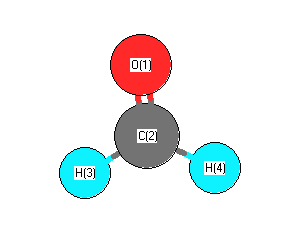.
| squib |
reference |
DOI |
| 1966Herzberg |
Herzberg, G., Electronic spectra and electronic structure of polyatomic molecules,Van Nostrand,New York, 1966 |
|
| 1974Hel/Hel(II/6) |
Hellwege, KH and AM Hellwege (eds.). Landolt-Bornstein: Group II: Volume 6 Molecular Constants from Microwave, Molecular Beam, and Electron Spin Resonance Spectroscopy Springer-Verlag. Berlin. 1974. |
10.1007/b19951 |
| 1976Bur/Mic:223 |
PD Burrow, JA Michejda "Electron Transmission Study of the Formaldehyde Electron Affinity" Chem. Phys. Lett. 42(2) 223, 1976 |
10.1016/0009-2614(76)80351-X |
| 1982Nak/Kon:3860 |
T Nakanaga, S Kondo, S Saeki "Infrared band intensities of formaldehyde and formaldehyde-d2" J. Chem. Phys. 76(8) 3860, 1982 |
10.1063/1.443527 |
| 1997Oln/Can:59 |
TN Olney, NM Cann, G Cooper, CE Brion, Absolute scale determination for photoabsorption spectra and the calculation of molecular properties using dipole sum-rules, Chem. Phys. 223 (1997) 59-98 |
10.1016/S0301-0104(97)00145-6 |
| 2003The/Cal:8910-8915 |
P Theule´ , A Callegari, TR Rizzo, JS Muenter "Fluorescence detected microwave Stark effect measurements in excited vibrational states of H2CO" J. Chem. Phys. 119, 8910 (2003) |
10.1063/1.1614771 |
| 2008Sch/Mei:44 |
A.M. Schulenburg, M. Meisinger, P.P. Radi, F. Merkt "The formaldehyde cation: Rovibrational energy level structure and Coriolis
interaction near the adiabatic ionization threshold" J. Molecular Spectroscopy 250 (2008) 44 - 50 |
10.1016/j.jms.2008.04.005 |
| Gurvich |
Gurvich, L.V.; Veyts, I. V.; Alcock, C. B., Thermodynamic Properties of Individual Substances, Fouth Edition, Hemisphere Pub. Co., New York, 1989 |
|
| webbook |
NIST Chemistry Webbook (http://webbook.nist.gov/chemistry) |
10.18434/T4D303 |












